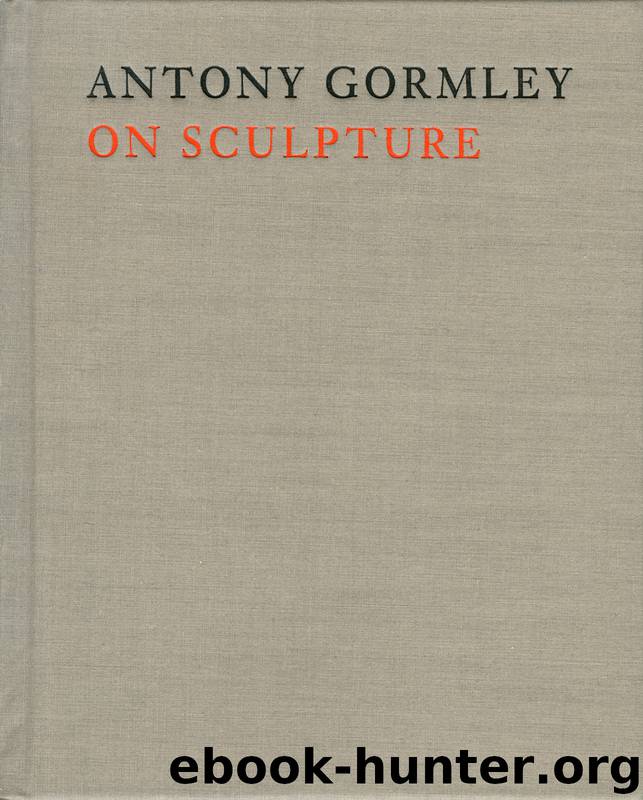Antony Gormley on Sculpture by Antony Gormley

Author:Antony Gormley
Language: eng
Format: epub
Publisher: University of Chicago Press
Published: 2016-03-22T04:00:00+00:00
Alberto Giacometti, La Place II (detail), conceived in 1948 and cast in 1949
Bronze with brown and black patina, length 64.7 cm (25½ in)
JOSEPH BEUYS
AND ‘PLIGHT’
1985
Plight, an extraordinary work by the German artist Joseph Beuys, is an installation first made in the Anthony d’Offay Gallery in Dering Street, London, in 1985. It is now part of the collection of the Pompidou Centre in Paris. In its original form, Plight consisted of two felt-covered rooms with a grand piano, a blackboard and a thermometer. It was the last great installation by Joseph Beuys and was made less than a year before his death in Germany in January 1986.
Dering Street is just off Bond Street, a noisy shopping street for the well-heeled, where people look into shop windows at objects for self-beautification. Entering the gallery was an unforgettable experience. You came up the concrete steps of a fairly generic staircase to the first floor, went through a pair of flush doors and immediately you were struck by the low light levels coming from bare bulbs, and you were aware that you were in an acoustically completely inert environment created by grey felt, the same as the felt underlay beneath the carpet of your living room. The felt was made up into body-like bales about 5 feet high, arranged in two rows. The ceiling height was 10 feet and the entire wall area from floor to ceiling was taken up by these two serried ranks of felt pillows. It was completely silent, in a way that was a total contrast to the world outside. You could walk around the two rooms. There was a large, black, polished grand piano, with the music stand open, but with nothing on it. On the top of the piano were a blackboard and a thermometer. The first room contained the piano and then you had to stoop down to go beneath the lowered threshold, only 5 feet high, to enter the second room where there was nothing except you. There was a sense of being completely removed from the world. You were aware of the space with its parquet floor and you began to be aware of your own body weight, of your own body temperature, of your position within this exclusive environment. You paced, maybe you ducked again, you went into the other room, you examined the evidence, were encouraged to take an interest in the pathology of this piano – the piano made in Germany, the piano made for playing, and here it was unplayed, unplayable within this context, but bringing to the mind’s ear that great tradition of sound, of Beethoven or Bach, Brahms, Schubert, Haydn, Wagner – the architecture of the German spirit. These objects that were obviously diagnostic – the thermometer and the blackboard – you could say that they were symbols of the medical bodily condition, and of the idea of instruction, of learning. They were catalysts for a sense that the viewer or subject could have of their own position in
Download
This site does not store any files on its server. We only index and link to content provided by other sites. Please contact the content providers to delete copyright contents if any and email us, we'll remove relevant links or contents immediately.
Picasso by Gertrude Stein(1215)
Modeling the Head in Clay by Bruno Lucchesi(1202)
Auguste Rodin by Rainer Maria Rilke(1048)
Modelling and Sculpture by Albert Toft(998)
Louise Nevelson by Laurie Wilson(883)
The Parthenon Marbles by Christopher Hitchens(879)
Antony Gormley on Sculpture by Antony Gormley(866)
Asmat Art by Dirk Smidt(853)
You Must Change Your Life by Rachel Corbett(839)
Modular Origami Polyhedra by Lewis Simon & Bennett Arnstein & Rona Gurkewitz(827)
Greek Art by John Boardman(825)
The TAB Guide to DIY Welding : Hands-on Projects for Hobbyists, Handymen, and Artists by Jackson Morley(825)
Origami Holiday Decorations by Florence Temko(776)
Origami for Beginners by Florence Temko(767)
Spiral Jetta: A Road Trip through the Land Art of the American West (Culture Trails) by Erin Hogan(758)
The Animal Gazer by Edgardo Franzosini(739)
Metal Clay Jewelry: Projects. Techniques. Inspirations. by Louise Duhamel(729)
The Pagan's Cup by Fergus Hume(715)
The Autobiography of Benvenuto Cellini (Penguin Classics) by Benvenuto Cellini(711)
